Our one-bedroom city condo doesn’t have much room for baby gear. Here’s what we bought to avoid clutter and create an organized baby space in our home.
Babies are small, but their stuff isn’t always similarly fun-sized. I thoroughly researched and tracked down the best space-saving versions of bulky baby essentials — strollers, cribs, swings, etc. — and got them for our baby.
Below I’m sharing the reasons behind all my choices, as well as some strong alternatives we considered in a few categories.
A little about our approach to baby gear shopping
About a year ago, when we found out we were expecting, one of our first reactions was to immediately start looking for a larger home. We’ve loved living in our one-bedroom city condo in Chicago for the past four years, and as minimalists, we’ve always felt we had plenty of room for the two of us alone, but since we’d soon be a family of three, our 770 square feet of living space suddenly felt way too small.
Fast forward a month or two and we stopped panicking. I spent most of my first trimester researching quality baby gear, and I was encouraged to find there were some great space-saving options for all of our baby essentials. I also learned that the American Academy of Pediatrics recommends that babies sleep in their parents’ room for the first year of life.
This news was a relief for me, as moving while pregnant and during the Covid-19 pandemic didn’t sound very fun. We no longer felt rushed to get a two-bedroom place before our daughter was born, and I was able to switch gears from obsessively searching Zillow and Redfin for a larger home to combing through reviews of the most suitable baby gear options for our single-bedroom home. Since we didn’t have an extra room for a dedicated nursery, I was determined to have the perfect nursery nook — one that was not only well organized but also fully functional, without skipping anything deemed essential by fellow mom bloggers.
Before I start this post, it’s important to note that, as minimalists, my husband and I really value quality and longevity in every purchase decision we make. Therefore, our selections were rarely the most affordable options on the market. However, the ability to buy these items once and re-use them for future kids and not worry about them failing or breaking and requiring a replacement made all these purchases well worth the money.
Are you in a similar boat? If you’re lacking extra space in your place and overwhelmed by the quantity of stuff you “need” for your first baby, these space-saving baby essentials may be the perfect solution for you.
Essential #1: Bassinet/Crib

I hated the idea of buying a separate bassinet and crib.
I knew I wanted a minimalist convertible crib, but I had the hardest time finding a crib that also worked for the newborn stage. I heard several YouTube parents recommend just using a Pack ‘n Play — there are some that even come with a bassinet and changing station that attach on top — but I didn’t like the idea of replacing the crib entirely with what’s supposed to be a portable on-the-go solution. Some aren’t rated for safe sleep, and they’re ugly. I really wanted something that would look good in our nursery nook! Thus began my search for a convertible “real furniture” crib + bassinet option.
If you search the Internet for convertible cribs, you’ll find there’s no shortage of crib-to-toddler-bed conversion options at stores like Pottery Barn Kids and Crate and Barrel. These are nice quality but pretty expensive. The conversion kits are also sold separately. In theory, it seems nice to have the option — maybe purchase it later when you need it! — but it was pretty apparent to me that you need to buy the conversion kit at the same time you buy the crib itself otherwise you run the risk of the style and color you choose no longer being available by the time you’re actually ready to convert. As I was focusing on shopping for our daughter’s first year of life, I didn’t even care much about the toddler bed (and beyond) anyway; we were planning to move before our daughter turned 1. The real problem I had with these is that they didn’t meet the need of a bassinet-style sleep space for the newborn phase. Now here you may be thinking, “Couldn’t I just use a crib from the get-go?” Sure, if you’ve got space for a full-size crib in your room before you actually need it — close to your bed so you can easily tend to baby multiple times throughout the night — and also if you don’t mind bending over the rails and reaching down low to pick up and put down your baby over and over again, which sounds especially not fun during the early postpartum period. (Yes, some cribs do have adjustable height options for the mattress, but again, you need to have the space available for a bedside crib.)
There were obvious reasons why I needed both a bassinet and a crib to get our daughter through her first year of life, but again I hated the idea of buying a separate thing that we’d probably only be using for the first few months until she outgrew it.
For months I researched until I finally found our perfect solution:
Our Solution: The Nestig Wave convertible crib

I was sold from the moment I discovered the Nestig convertible crib existed. This thing checked all my boxes. It converts from a mini crib to a full size crib to a toddler bed. We only have to store one box that contains both the pieces for the crib conversion and the toddler bed, and that box is currently perfectly hidden behind our couch. There’s only one purchase to make, and that purchase includes all the conversion parts. It even comes with a mattress for the mini crib. Plus, it costs less than the Pottery Barn / C&B options that aren’t as versatile.
Alternate Solution: The Stokke Sleepi Mini with crib/bed conversion
The only other option I considered for a stylish safe sleep solution was the similar Stokke Sleepi crib with the junior bed conversion kit. It’s an oval shape which would have fit better in our bedroom than a standard crib, which is why we considered it. The Stokke is pretty, but it’s pricier and I was just so annoyed with having to shop for and purchase multiple things with varying stock availability. Plus, to this day I’m confused about what pieces you have to buy in order to have the full convertible setup from the Mini and upward. Because of the unique oval shape, another downside is you have to buy the mattress from Stokke, too. (A standard crib mattress fits in the Nestig cribs.) All my issues with it aside, some people really love this crib. If you’re not worried about the price or multi-part purchasing, you might love it, too, but if it’s pretty clear that the Nestig is the simpler, more wallet-friendly option.
Essential #2: Swing, Bouncer or Dock
Unlike when you’re pregnant, you can’t carry your baby all day every day. There are a plethora of swings, bouncers, and loungers on the market, but the majority of them, including the super trendy Mamaroo swings, require their own full-time real estate in your living space. So I searched and I found the best well-reviewed fold-away bouncer and swing solutions that fit our needs. Do you need a bouncer, a swing AND a lounger? Probably not. Do you need any of them? Maybe not, but depending on your baby and your specific needs as a parent, each one may or may not be an essential for you. I would say, at a minimum, I recommend having at least one portable option so you have a quick place to put your baby down if you need to.
Our Solution #1: BabyBjorn Bouncer Bliss
The BabyBjorn Bouncer Bliss is definitely on the pricey side when it comes to bouncers, but I liked how well it was made and that it would support more weight than other bouncers on the market and thus could be useful for a longer period of time. It also folds down flat for easy storage. We got the toy attachment for ours, so she’ll have something extra to do while she sits in the bouncer. Of the three portable “docking” options we have for Atlas, this is probably the most versatile for moving it around and setting it down in different areas of our home, as it’s light enough to easily carry with one hand and the base of it works fine on any flooring type.
Our Solution #2: Munchkin Bluetooth-Enabled Baby Swing

The Munchkin Bluetooth Swing is similarly pricey when it comes to swings, but it can also be stored flat. I love that it has a remote so I can change the speed settings and sounds/music without bending down and disturbing our baby by touching the buttons on the swing itself (which is also an option). It has several sound options. I especially like the nature sounds, and the classical music is pretty good, too. We’ve been using the swing more than the bouncer in our daughter’s younger newborn phase. It comes in handy when Ian and I are eating a meal together and need to put her down for a little while.
Alternate Solution: Dock-A-Tot or SnuggleMe Baby Lounger
Before the whole baby industry was turned upside down with the recall of the Boppy Newborn Lounger, we got one. I was really excited about it in the beginning, and then it was recalled less than a month after she was born. Boppy’s lounger has all but disappeared from the Internet, but you can still find some of a similar design (e.g. the “Nuby Nest“) on Amazon.
Other baby lounger options I considered included the DockATot (0-8 months) and SnuggleMe (0-9 months) newborn loungers. After first hearing those two options were “unsafe” — I don’t think DockATot even sells directly to U.S. customers — I’d decided against those and opted for the more affordable choice. Really all loungers are considered unsafe without supervision, especially and most notably for sleep, but many parents find them reasonable to use if you’re watching your baby. The flat designs of the DockATot and SnuggleMe made them seem more geared toward sleep to me, which wasn’t what I planned to use a lounger for, so that was another reason I’d settled on the Boppy.
The first time I put our 6-pound newborn in the Boppy lounger, I quickly decided it didn’t look like a safe position for her to be in. (It pushed her neck/head too far forward, placing her in a slumped position.) I started having nightmares about positional asphyxiation. (This was even before the thing was recalled.) We ended up using a small baby pillow to adjust her positioning when we used it. Now that our daughter is 2 months old, we haven’t used the Boppy since it was recalled, but we’re finding more and more times when we need to put her down for just a minute.
Now I’m finding myself really wanting a DockATot or SnuggleMe. Like any other baby product, these things are only considered “unsafe” with unsupervised use, and now that I’ve had a newborn of my own for a while I have a better understanding of how to navigate what’s truly unsafe and what will actually be a great solution for a particular need our family has.
While the SnuggleMe loungers are considerably less expensive than the DockATot, the DockATot has a “Grand” option that grows with baby from 9 months to 3 years of age. We’ll probably be sticking with just her swing and bouncer for now, but I’ll definitely be keeping my eye out for Black Friday deals.
Essential #3: Changing Station
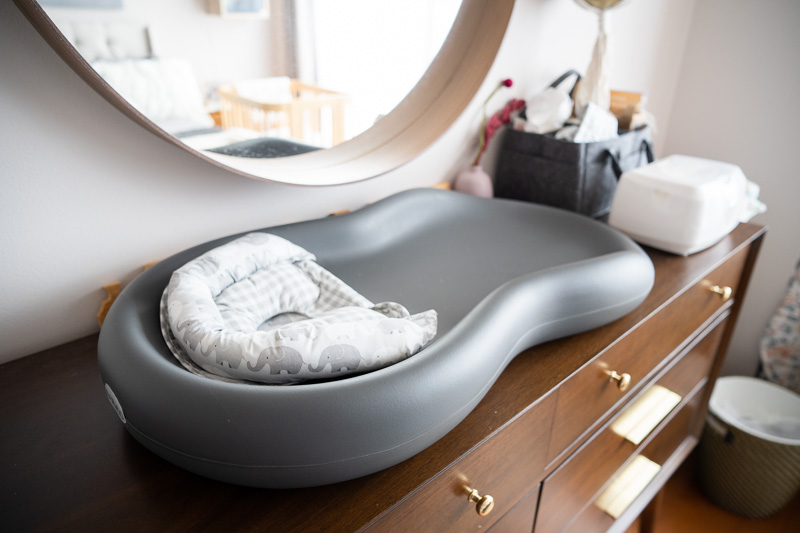
Previously, we did not have a dresser in our room.
My husband and I share a closet, which works totally fine for two people but leaves little extra room for baby clothes. I was reluctant to buy a new piece of furniture. Lots of parents recommend the dresser-top changing station solution, but they’re usually using one that already lives in their space or buying one for a dedicated nursery room.
A changing table was an okay option for us, but we did still have a need for storage space for baby’s clothes.
I also considered just using a large foldable changing pad and routinely changing her “wherever we are” — the bed, the couch, the living room floor — as plenty of minimalist parents also recommend doing.
Our Solution: Dresser + Keekaroo Peanut Changer
Ultimately we decided the dual purpose of a dresser was the most ideal for us, so we ordered a dresser and the popular Keekaroo Peanut changer to put on top with a felt diaper caddy. Our daughter is totally spoiled and now also has a wipe warmer (sanitized regularly to keep it clean). A night light may also be helpful for nighttime changes for some parents, but we just click on one of our dim bedside lights.
I’d also add drawer organizers as an essential for the dresser option, because baby clothes and other items are so small it’s impossible to optimize your drawer space without segmenting your drawer space. We like the Skubb collapsible storage bins from Ikea, but you should find an organization option with dimensions that fit your drawer space and needs.
Essential #4: Sound Machine
I almost registered for the popular Hatch Rest sound machine night light combo, but it was honestly way more than we needed. We didn’t need the light, and we didn’t have any tabletop space to spare. Plus, it was a bit pricey, and the reviews I read just didn’t convince me that it was worth the money.
Our Solution: Myla The Monkey
A portable sound machine takes up less space and is also dual-purpose because you can take it on the go when you need to. There were a lot of 4+ star options for portable sound machines on both Amazon and BuyBuyBaby, but after reading lots of reviews, I happily settled on Myla the Monkey.
Myla is easy to use, USB rechargeable (we actually keep ours plugged into the wall most of the time), and it has both white noise and lullaby options. I keep forgetting this, but it actually has a really nice little light on it, too.
If Myla’s not the perfect option for you, lots of parents will tell you to get a USB rechargeable one at the very least, because replacing batteries is annoying. As a side note, we also have the Baby Shusher, which serves a separate purpose from the white noise machine, as it helps soothe her to sleep and runs on a timer rather than drowning out background noise around the clock. After putting our daughter to sleep, it makes sneaking out of the room much easier.
A Note on "just in case" items: If you’re not sure you need something like the Baby Shusher, you could always have it on hand before baby arrives and then just return it if you don’t use it. Most registries have pretty generous return policies from a timing perspective, so be sure to buy through your registry for everything you can -- especially items you’re not 100% sure you’ll use. You obviously don’t want to go overboard on items you're not sure you'll need, but for certain things, when you decide you need them, you need them now, and even one-day Amazon shipping won’t feel fast enough.
Essential #5: Stroller

Of all the baby gear I researched, I spent the most time on strollers. I was torn between (1) a compact option that would be the easiest to maneuver in and out of our small living space as well as inside city restaurants and shops, and (2) a more standard-sized model that converted to a double stroller for the future when we would possibly have more children.
I watched lots of YouTube reviews comparing different models.
Standard-sized contenders included the UppaBaby Vista V2 and the Mockingbird Single-to-Double stroller (both convertible options).
Lightweight/compact stroller options I considered were the Bugaboo Ant (ultra compact), the Bugaboo Bee6 complete stroller including the bassinet and the Babyzen YOYO2 complete stroller including the 0+ folding newborn pack. An affordable option I looked into was the Graco Modes system.
Every stroller option I considered had the ability to snap an infant car seat onto them, which was essential for us, as we usually have a 5-10 minute walk between our car and home.
Our Solution: Babyzen Yoyo2 6+ Stroller with 0+ Newborn Pack
After months of research we finally decided on the Babyzen Yoyo2 with the 0+ Newborn Pack add-on. As the price can vary for the Newborn Pack, I recommend purchasing it separately and shopping around for different colors.
It’s a “carry-on size” stroller with the functionality and flexibility of a standard travel system. It accepts an infant car seat with adapters, features all-wheel suspension, and I watched reviews saying it was more comfortable than other stroller options we considered. It also folds up fast, is possible to fold with only one free arm, and has a shoulder strap to carry the folded stroller. We figure these features will really come in handy whenever we start traveling again, but the fast fold is already coming in handy for putting the stroller in and out of the car.
The stand-out feature and deciding factor of our selection was the folding bassinet. The stroller folds up not only with the 6+ seat, but also with the 0+ newborn pack attached. Unlike our other options, you don’t have to constantly remove and reattach the bassinet to collapse the stroller, and the car seat fits on right on top of the newborn pack. Note: Babyzen offers a more structured, non-folding bassinet option as well, if you prefer.
The Babyzen Yoyo2 was already slightly more affordable than the Bugaboo Ant (the most comparable stroller) with all the options we needed, and when I found the newborn pack on sale at BuyBuyBaby, I pulled the trigger and bought it.
The only downside I found about the Babyzen is that the toddler seat doesn’t have a parent-facing option, but all of its other features made it the best option for us. We also decided that if we did end up having another baby relatively soon, we wouldn’t regret starting with the Babyzen, as it would still be nice to have for travel, even if we did need to upgrade our daily stroller to a double eventually.
Essential #6: Bath Tub
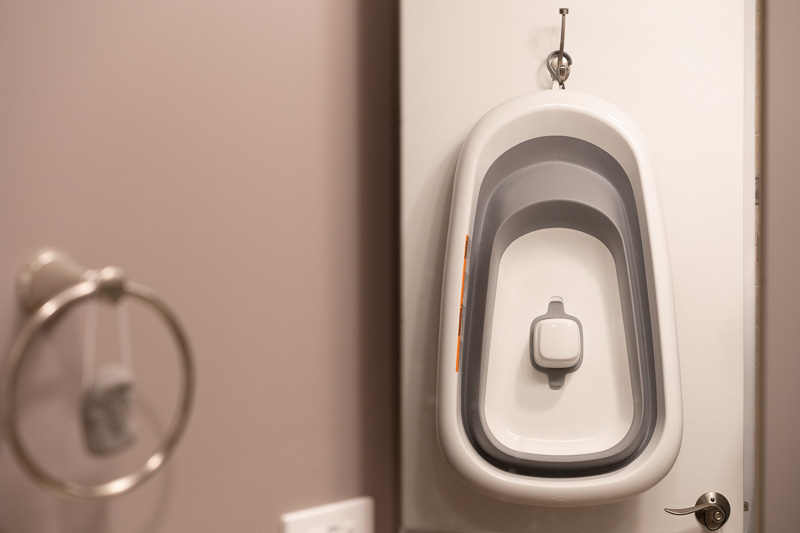
If you don’t have a bath tub in your space, or if you’re worried about getting back pain from leaning over the side of a tub, a baby bath solution is a requirement for you.
A baby bathtub seems like it would be an easy item to decide on, but for some reason it was one of the hardest for me. We have a shower in our place (no tub), so we wanted some sort of tub solution for our baby girl. I had three options that each worked better for a particular stage of babyhood. Ultimately I chose the tub that best matched my desire for an all-in-one solution, but depending on your home’s bathroom setup, a different option, or combination of options, may work better for you.
Our Solution #1: Puj’s Foldable Infant In-Sink Bathtub
At first we bought the Puj Tub, which stores flat and folds to fit in a small bathroom sink. It essentially turns your bathroom sink into a slightly larger, padded basin. Puj also offers a smaller option, the Puj Flyte, which folds in half and takes up less wall space when hanging it to dry. Both Puj options are marketed as “infant” tubs and only work up to 6 months of age, so I ended up returning the Puj for a larger free-standing option that also stored pretty flat.
Our Solution #2: OxoTot Collapsible Baby Bathtub
The OxoTot collapsible tub (Target / BuyBuyBaby) is definitely thicker, larger, and heavier than the Puj. However, I really liked the idea of just buying one tub rather than needing a new one once our daughter grew out of the first, so I chose the OxoTot. I also bought a bath time kneeling pad since the tub is too large to set on top of our bathroom vanity. We use the tub either in the bottom of the shower or on the bathroom floor. Admittedly, I now kind of regret returning the Puj, as my back pretty much kills me whenever we bathe our daughter kneeling on the bathroom floor. This is mainly because a newborn can’t support their own head so extra support is required to keep the baby in a good position, which can get very uncomfortable.
To save my back, I just re-ordered the Puj Tub. Even though we’ll only be using it for a few months, it’s worth it to me to have bath time be more enjoyable in our small space.
Alternate Solution: Stokke Flexi Bath
A third small-space friendly baby bathtub option is Stokke’s folding baby bath tub. It’s a very simple rectangle that folds flat for storage, and they offer a version of the Stokke Flexi that includes newborn support. I chose the OxoTot over the Stokke because I like the OxoTot tub’s newborn solution better: a bump in the middle that your baby straddles, which keeps newborns from sliding down too deep into the tub. The Stokke’s newborn insert is supposed to function similarly. I also liked that the OxoTot has a hook to hang it for storage. (We hang ours on the back of our bathroom door.)
Now that I’ve had several weeks of experience bathing our baby girl, as much as I hate buying two separate things, we’re opting to have both the Puj and the OxoTot. If you have a tub in your bathroom, you may not need a collapsible floor option, but there are definitely some advantages when compared to a standard tub, including:
- ease of draining and refilling if needed during the bath
- less water required
- built-in infant support
Essential #7: Storage
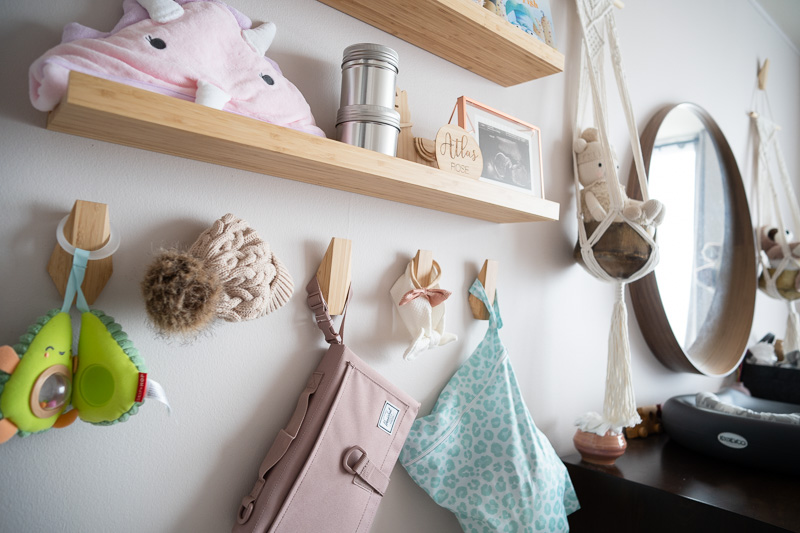
If you’re living in a truly small space, making the most of the space you have available for storage is a must.
For us, this meant making use of open wall space by adding hooks and shelves throughout our bedroom. I also found some foldable storage bins that fit perfectly under our dresser. Before I was ever even pregnant, we started using a combination of under-bed storage bins from Ikea to make the most of the space under our bed, too. Lastly, a tiered roller cart will certainly come in handy for portable storage, if you have a spot for one. Ours is from Ikea, but you can get them from other places like Bed Bath and Beyond, too. I use mine to store swaddle blankets, pump parts, and small miscellaneous items like stroller toys and pacifiers.
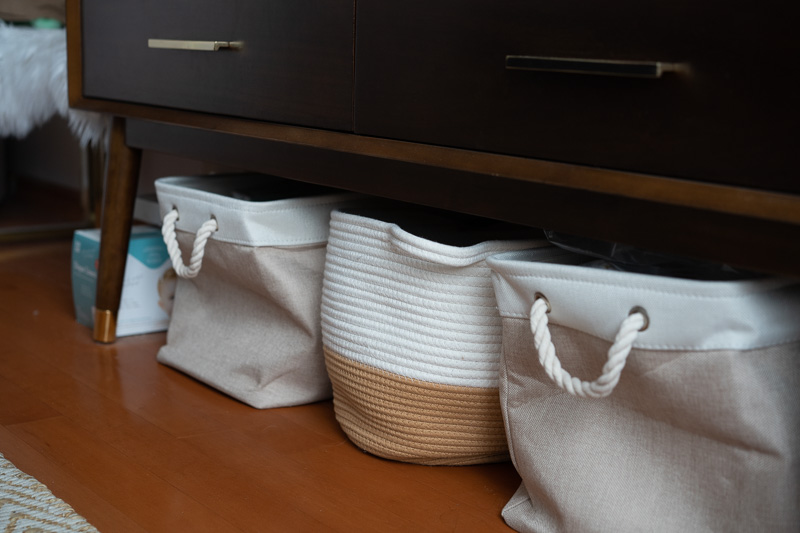
Regardless of what you’re using for storage, sub-dividing your storage space makes organizing tiny baby things much easier. My favorite affordable drawer organizer set is the Skubb set from Ikea.
Essential #8: Drying Rack
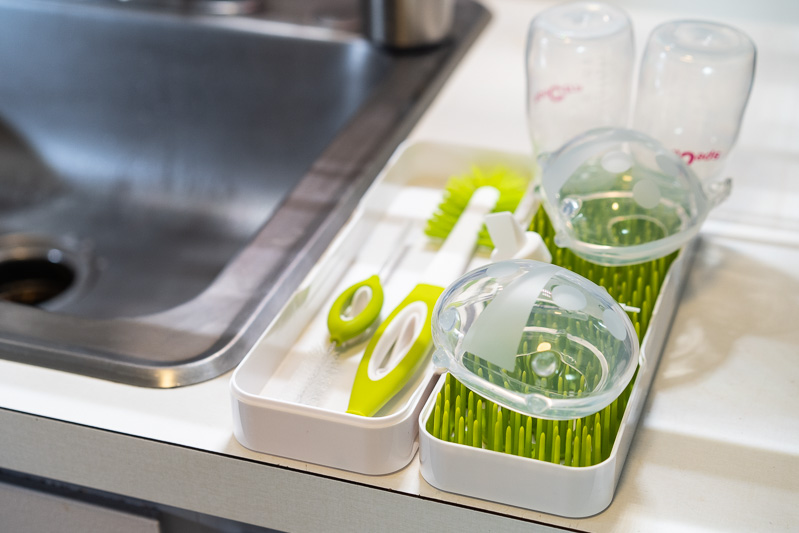
The size you need will depend on whether you’re breastfeeding or formula feeding, but having a small dedicated space for baby feeding stuff to dry will help keep your kitchen and supplies more organized. We exclusively breastfeed with occasional bottles, and we’ve gotten by with using only a travel bottle brush and drying rack set in our tiny urban kitchen.
To give you an idea of things we commonly use and wash:
- Silicone milk catchers
- Vitamin D syringe
- NoseFrida snot sucker
- Occasional pump parts
- Occasional bottles
- Pacifiers
If you’re using bottles more frequently, you might want a larger drying rack specific for bottles. I wasn’t sure how many bottles we’d be using so I considered registering for this vertical bottle drying rack from OxoTot, but we didn’t end up needing it. We only have a total of four bottles we use — two for pumping and two for feeding — and it’s on pretty rare occasions that we use them, so the travel size option is perfect for us.
Essential #9: Diaper Clutch
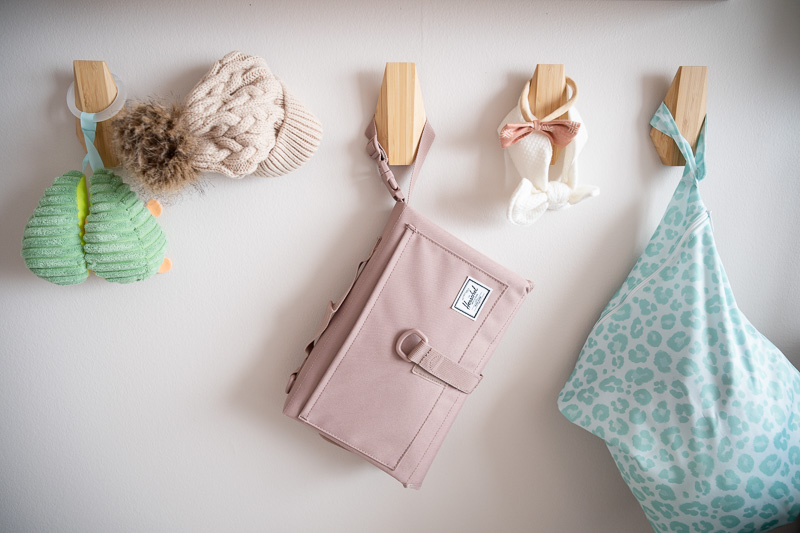
One day you will venture outside with your newborn. While a dedicated diaper bag is essential for some outings, sometimes you can get by with the bare essentials: diapers, wipes, and a spare onesie.
We keep all this in a diaper clutch — Herschel Baby Sprout change mat — which we’ve taken along for plenty of walks in the park and quick trips in the car. It easily attaches to our stroller via the velcro strap on its handle. I picked out this clutch long before our diaper bag, and it got us through our first few weeks with a newborn, as I still hadn’t decided on what diaper bag I wanted (or if I needed one at all).
Essential #10: Diaper Bag
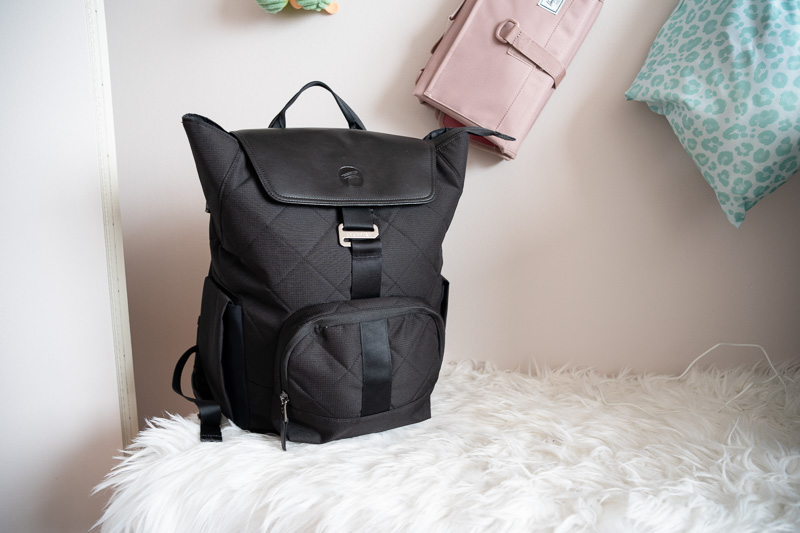
I decided I needed one.
The diaper clutch is nice when you only need the essentials, but for longer trips away from home, you’ll need more diapers than the clutch can hold and likely a few other things. I put off my diaper bag selection forever, because I was super picky and wasn’t convinced we actually needed one. We knew we wanted a backpack-style bag that both my husband and I would be comfortable carrying, and it needed to include a diaper changing pad. We could accomplish this by putting the diaper clutch inside a backpack we already owned.
At some point, ads for Paperclip’s diaper bags started popping up in my Facebook feed, and after I saw that their design included an integrated diaper changing station, I was sold. It’s better than your standard-issue changing pad, because Paperclip’s pads are attached to and fold out easily from the backs of the bags. This keeps baby and all of your changing necessities enclosed and also offers a bit more privacy. I only needed to choose between their Jojo (smaller) and Willow (larger) bag designs. We ended up with the Jojo in black, and we like it a lot.
Now, if I hadn’t discovered this unique diaper bag solution that includes the diaper changing station, I probably never would have bought a “diaper bag” and would have been perfectly satisfied with just using a backpack. If you don’t like the Paperclip and can’t find another diaper bag with a special feature you love like we did, any backpack or tote should suffice.
That wraps up my list of baby essentials for small spaces.
Have you discovered any space-saving baby gear that you can’t live without? I’d love to hear about it, and I’m sure other readers would, too. Drop a comment below and let me know!
